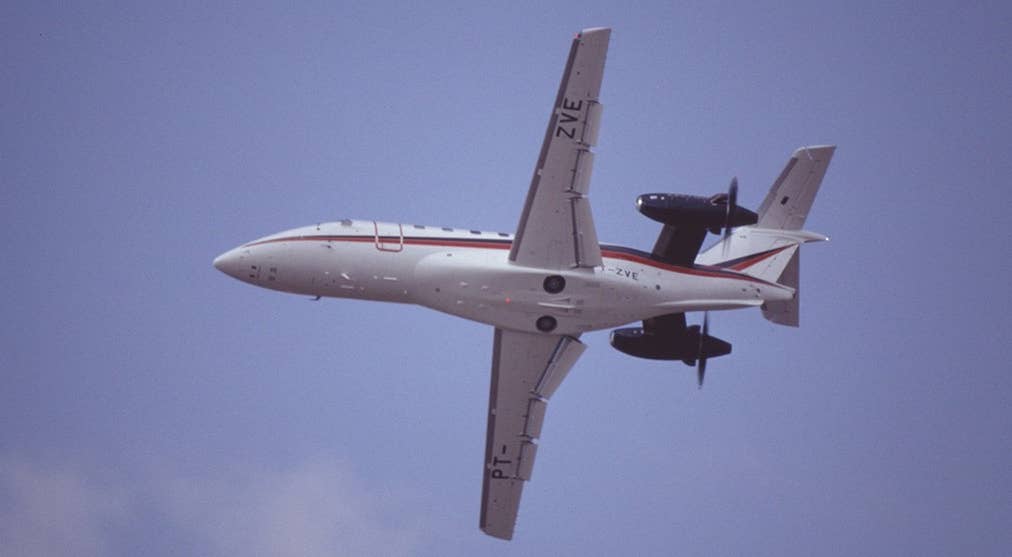Expense Ultimately Doomed Fast, Quiet CBA-123 Vector
Unconventional engineering effort was a clean-sheet reimagining of the 19-seat airliner that later fueled development of the ERJ-135/145 series of regional jets.

From directly below, the CBA-123’s unique wing and unconventional engine configuration are plainly visible. [Credit: Kev Slade]
Airliner design, by and large, tends not to embrace the unconventional.
Whether jet or turboprop, we generally see only two general layouts—engines mounted on the wing or aft pylons, and propellers are almost exclusively mounted on the wing. Chalk the lack of variety up to convergent evolution or to operators and markets that favor conservative predictability, but it’s a reality that was almost universally adhered to by major airframe manufacturers.
That is, until the Embraer CBA-123 Vector.
A joint engineering effort launched in 1986 between Brazil’s Embraer and Argentina’s Fábrica Argentina de Aviones (FMA), the CBA-123 was a clean-sheet reimagining of the 19-seat short-range airliner. A segment populated by types like the EMB-110 Bandeirante, Dornier Do-228, and Beechcraft 1900, Embraer and FMA saw the potential to utilize new technologies to create a better-performing and more comfortable aircraft for the 1990s.
Beginning with a shortened fuselage of the 30-passenger EMB-120 Brasilia, the team started from scratch on the powerplants, wing, and many aircraft systems. It worked with the Garrett division of AlliedSignal to develop a new version of the proven TPE331, an engine utilized on such types as the BAe Jetstream, Fairchild Metroliner, and Mitsubishi MU-2.
Most notably, the new engine incorporated a pusher design. By placing the six-bladed propellers well aft of the cabin—nearly 12 feet aft of the rearmost passenger seats—less noise and vibration made it to the cabin, resulting in a quieter, smoother ride for passengers. Pilots reported little to no engine/propeller noise making it to the flight deck, providing a decidedly jet-like flying experience.
While, at first glance, the pusher turboprops might appear to be the most notable aspect of the aircraft, the unique wing was quite unlike existing wing designs.
Unlike other turboprops, the rear-mounted engines created a clean wing without large engine nacelles to disturb the airflow. To minimize cruise drag, the wing was designed with a high aspect ratio and 20-50 fewer square feet of wing area than other 19-passenger turboprops. Additionally, the wing profile incorporated more camber at the trailing edge than traditional wing designs.
The result was greatly increased performance and a true evolution beyond existing 19-passenger turboprops. With a cruise speed demonstrated in flight tests of 328 knots, the CBA-123 was roughly 50-150 knots faster than comparable turboprops and could cruise some 10,000-13,000 feet higher. Despite the higher cruise speed, the advanced wing enabled approaches as slow as 90-100 knots at light weights and 110-120 knots at heavier weights.
U.S. airlines were intrigued. So intrigued, they placed some 130 soft orders for the CBA-123.
This enthusiasm, however, was predicated upon a relatively competitive target price of $3 million. When the price ballooned to roughly twice that amount, the airlines realized that while passengers would surely appreciate the additional speed, quieter cabin, and capability to climb above bad weather, they wouldn’t be willing to pay the premium necessary to absorb the cost increase.
Accordingly, the program was canceled in the early 1990s, and no further examples beyond the three prototypes were constructed. However, Embraer learned a great deal throughout the development process and applied this experience to the development of the ERJ-135/145 series of regional jets that saw massive success in the market.
Fortunately for enthusiasts of aviation and aeronautical engineering, each prototype was preserved and is on display at various locations in Brazil and Argentina.

Sign-up for newsletters & special offers!
Get the latest FLYING stories & special offers delivered directly to your inbox






